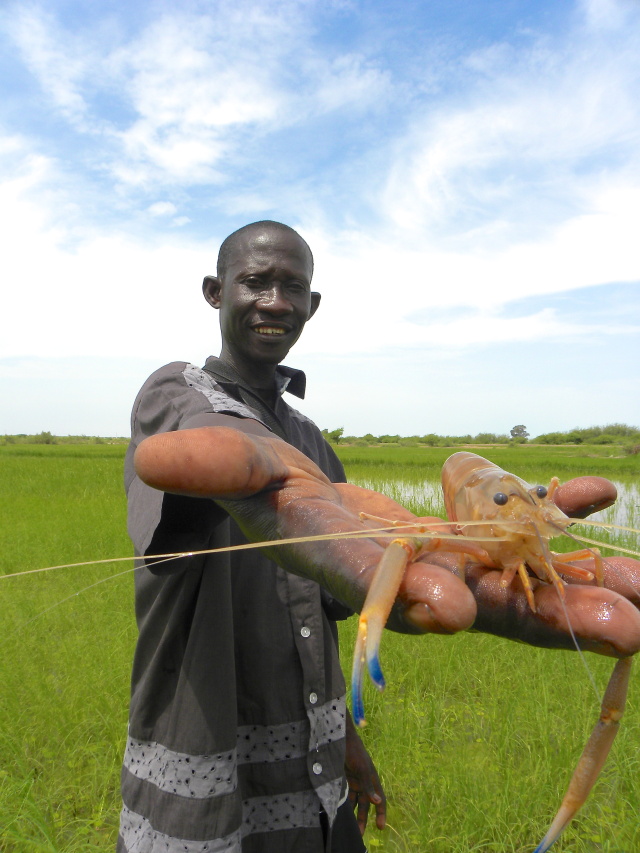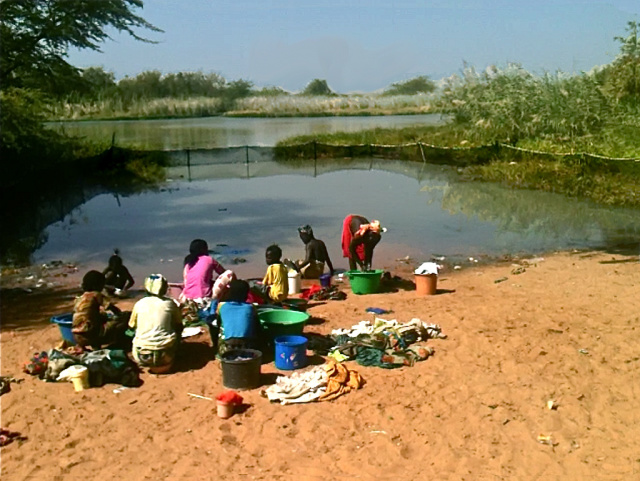
It's a familiar ecology story: human dam-building activities in the 1980s wiped out a species of prawn in the Senegal River by blocking its migration routes. But this tale takes an unexpected turn into human health. A pilot study suggests that reintroducing the prawns to the river wouldn’t be good just for biodiversity—it could also help to control a parasite that causes disease in humans.
The research, published today in PNAS, found that when river prawns were reintroduced to a village’s water supply, the number of parasite-carrying water snails dropped substantially compared to a village with no prawns. This drop had a significant impact on the disease levels of the villagers.
No-one wants spiny eggs in their bladder
The construction of the Diama Dam in 1986 was followed by a massive epidemic of a nasty disease called schistosomiasis, occurring in the villages along the river. Schistosomiasis, also known as bilharzia, is a waterborne disease with a life cycle straight out of a horror movie: after the larvae penetrate human skin, they go on to mature in the intestine or bladder. The sharp, spiny eggs laid by the females—between 350 and 2,200 per day—are able to penetrate tissues, allowing them to travel through the body.
If their travel is interrupted, they can get stuck in an organ and stay there, causing inflammation. Complications can be extreme, causing death from liver failure or bladder cancer. Children can suffer cognitive impairment and stunted growth.
Schistosomiasis is one of the biggest diseases most people have never heard of. Approximately 230 million people are infected by the parasite, and because infection and drug treatment don’t enable the body’s immune system to deal with the infestation on its own, reinfection is easy and common. Death rates are difficult to estimate because the actual cause of death may be indirect—such as deaths from bladder cancer—so estimates range from 20,000 to 200,000 deaths per year.
The millions of infected people, and a further estimated 790 million who are vulnerable to infection, live in some of the world’s poorest areas (mostly in Sub-Saharan Africa). That makes providing a constant supply of drugs to treat never-ending reinfection a less-than-ideal solution.
Eating the messenger
It’s better, clearly, to suss out the causes of the disease and manage those. The parasites that cause schistosomiasis have a complex life cycle, spending part of their lives using vertebrates (such as humans) as their hosts and an intermediate stage living in molluscs like snails. When the Diama Dam was built, it seems to have created a paradise for the snails that act as intermediate hosts. It did this by reducing the amount of saltwater that flowed up the river, encouraging plant growth and, most importantly, eliminating the river prawn that preyed on the snail.
Before the dam was built, female prawns would migrate downstream to lay their eggs in the estuary, and hatched larvae would migrate upstream. The Diama Dam was small, but it was large enough to put an end to the annual return trip, meaning no more prawns upstream in the river where villagers use the water. In the absence of predators, the snails flourished.

Lab experiments have shown that, in captivity, prawns can control snail populations, and fieldwork in Kenya has shown that introducing North American crayfish to the area can control schistosomiasis. However, it’s always possible that what works in one place doesn’t work in another.
Prawns taste (and work) better than medicine
To test whether it would be worth investing in an effort to reintroduce prawns to the Senegal River, the researchers chose two villages along the river bank. One village would receive schistosomiasis medicine; the other would get schistosomiasis medicine, plus prawns. To keep the prawns in an enclosed area, nets were installed near the river bank, creating a patch of prawn-abundant water alongside the village.
After 18 months, snail populations had halved in the prawn enclosure compared to the control village. People using water from the prawn enclosure showed lower rates of infection compared to their rates at the start of the trial.
The number of parasite eggs in urine is the best way to establish how many people will fall ill, the authors write. In the village with the prawns, this dropped from an average of 31.9 eggs per 10 mL of urine down to 10.2 eggs—a drop of 68 percent. By contrast, the control village started with a lower rate and went up during the trial, from 6.5 to 18.3 eggs per 10 mL of urine. It’s not clear why disease rates rose in the control village.

The results aren’t proof that the prawns were the change that brought about the reduction in disease rates, the authors write. It’s possible that there were other differences between the villages that weren’t noticed or that the nets had other effects, perhaps reducing the snail population regardless of the prawns. Nonetheless, the results did match up with what we know about the parasite’s life cycle as well as lab research and the fieldwork in Kenya.
It will be necessary to replicate these results before forging ahead with prawn restoration, but in the meantime, it’s possible to think about how this restoration could be achieved. Natural ecosystems have river prawns at numbers higher than necessary to control snail populations, so building a prawn “ladder”—a series of shallow steps in the river allowing animals to bypass the dam and travel normally along the river—to restore the natural population seems like an ideal solution.
Restoring the population would have other benefits too. Because larger prawns prey on smaller prawns, catching and eating the larger prawns could have economic benefits and provide a new food source, while still leaving enough smaller prawns to eat the snails, the researchers suggest. Working out whether this assumption is correct and what the economic effects would be are necessary steps before taking the project further.
It’s not often that human interests and conservation efforts are so neatly allied. If this pilot project holds up under the scrutiny of further research, it could be a cost-efficient and highly beneficial way to combat schistosomiasis.
PNAS, 2015. DOI: 10.1073/pnas.1502651112 (About DOIs).
Listing image by Nicolas Jouanard (Project Crevette)
reader comments
47